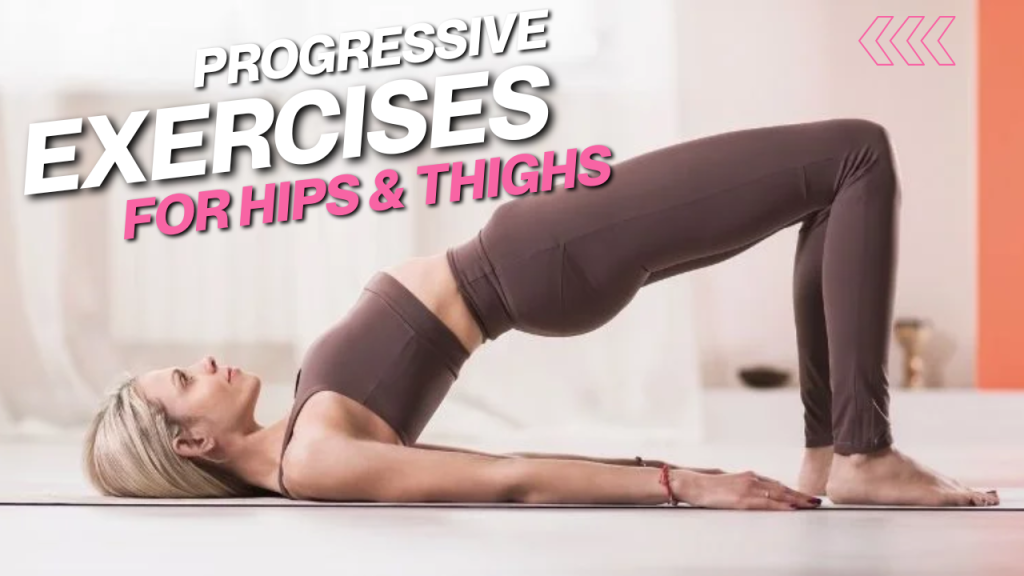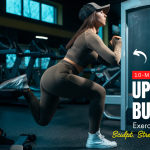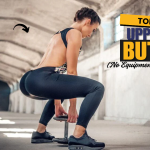Ever feel like your lower body workouts are stuck in a rut? Whether you’re looking to tone, strengthen, or sculpt your hips and thighs, the key is progressive overload — gradually challenging your muscles with purpose-driven movements. This guide takes you from beginner-friendly basics to advanced compound exercises for hips & thighs that truly transform.
Let’s turn those squats into serious gains — and no, this isn’t just another list of glute bridges. These 8 progressive moves are carefully curated to activate all major muscle groups in your hips and thighs, ensuring balanced strength, stability, and definition. Ready to go from beginner to beast?

Table of Contents
Perks of Progressive Hip and Thigh Exercises
- Tones and Sculpts Your Lower Body
Shapes your glutes, thighs, and hips for a leaner, more defined appearance.- Boosts Strength and Stability
Strengthens large muscle groups, improving overall lower body power and functional movement.- Enhances Athletic Performance
Increases agility, speed, and explosiveness — ideal for running, jumping, and sports.- Improves Balance and Posture
Strengthens core stabilizers and corrects muscular imbalances, reducing the risk of falls or injury.- Burns Calories and Fat Efficiently
Compound movements activate multiple muscles, leading to higher calorie burn during and after workouts.- Supports Joint Health and Mobility
Strengthening the muscles around the hips and knees provides better support and flexibility.- Boosts Metabolism
Builds lean muscle, which helps raise your resting metabolic rate — meaning you burn more calories even at rest.- Reduces Risk of Injury
Stronger hips and thighs mean better alignment and less strain on joints and the lower back.- Easy to Progress and Customize
Exercises can be scaled up or down based on your fitness level — from beginner to advanced.- Improves Confidence and Body Awareness
Seeing strength and tone improve builds self-confidence and a deeper connection with your body.
Do’s & Don’ts of Hip & Thigh Exercises
| Do’s | Don’ts |
|---|---|
| Warm up with dynamic stretches | Don’t skip your warm-up |
| Focus on proper form before adding weight | Don’t prioritize weight over technique |
| Engage your core during every movement | Don’t let your back arch or collapse |
| Breathe steadily — inhale with effort | Don’t jump into advanced exercises too soon |
| Use progressive overload intelligently | Don’t repeat the same routine forever |
| Breathe steadily — inhale on effort | Don’t hold your breath during exercises |
| Rest 24–48 hours between leg sessions | Don’t train the same muscle daily |
| Modify if you feel discomfort | Don’t push through sharp pain |
| Cool down and stretch post-workout | Don’t neglect recovery and mobility |
| Stay consistent for best results | Start with bodyweight to master the basics |
What to Expect After 30 Days of Progressive Hip & Thigh Exercises
| Time Frame | Expected Changes |
|---|---|
| Week 1 | Improved muscle activation and mind-muscle connection. Slight soreness (DOMS) may occur. |
| Week 2 | Increased stamina and better form. Muscles feel more engaged and workouts feel smoother. |
| Week 3 | Noticeable strength gains. Slight definition in thighs and glutes. Improved balance. |
| Week 4 (Day 30) | Visible toning and firmer hips/thighs. Boost in confidence, posture, and daily energy. |
| Bonus Benefit | Increased stamina and better form. Muscles feel more engaged, and workouts feel smoother. |
Why Focus on Hips and Thighs?
Your hips and thighs are home to the body’s largest and most powerful muscles — the glutes, hamstrings, and quadriceps. Training these muscles improves:
- Posture and alignment
- Athletic performance
- Balance and injury prevention
- Metabolism and fat burning
- Aesthetic shape and symmetry
Now, let’s get into the exercises — categorized by levels and built for progression.
Level 1: Foundation (Beginner)
1. Glute Bridge
Target: Glutes, hamstrings
Why: It builds a mind-muscle connection and strengthens the posterior chain without stressing the knees.
How to Do It:
- Lie on your back, knees bent, feet flat on the floor.
- Push through your heels to lift your hips toward the ceiling.
- Squeeze the glutes at the top. Lower slowly.
Pro Tip: Add a mini band above your knees to increase activation.
2. Bodyweight Squat
Target: Quads, glutes, core
Why: Fundamental movement pattern that lays the groundwork for all lower body exercises.
How to Do It:
- Stand with feet hip-width apart.
- Lower your hips back and down, keeping your chest up.
- Push through your heels to stand back up.
Pro Tip: Practice in front of a mirror to ensure proper form.
Level 2: Strengthen & Stabilize (Intermediate)
3. Bulgarian Split Squat
Target: Quads, glutes, hip flexors
Why: Challenges balance and isolates each leg for better muscle symmetry.
How to Do It:
- Place one foot behind you on a bench or step.
- Lower into a lunge until your front thigh is parallel to the floor.
- Press through the front heel to rise.
Pro Tip: Hold dumbbells once bodyweight becomes too easy.
4. Step-Ups
Target: Quads, glutes, hamstrings
Why: Improves unilateral strength and mimics real-life movements like climbing stairs.
How to Do It:
- Step up onto a bench or box with one leg.
- Push through the heel to lift your body.
- Lower slowly and repeat.
Pro Tip: Drive through the heel and avoid pushing off with the back foot.
Level 3: Power & Progression (Advanced)
5. Barbell Hip Thrust
Target: Glutes, hamstrings
Why: This is one of the most effective exercises for maximal glute development.
How to Do It:
- Sit with your upper back against a bench, barbell over hips.
- Drive through your heels to lift your hips.
- Squeeze at the top and lower with control.
Pro Tip: Keep your chin tucked to avoid overextending your lower back.
6. Walking Lunges
Target: Quads, glutes, hamstrings, calves
Why: It builds coordination, strength, and endurance simultaneously.
How to Do It:
- Step forward into a lunge.
- Push off the back foot and bring it forward to repeat on the other leg.
Pro Tip: Add weights for intensity and maintain an upright posture throughout.
7. Sumo Deadlift
Target: Glutes, inner thighs (adductors), hamstrings
Why: It builds a powerful hip drive and strengthens the posterior chain with extra focus on the inner thighs.
How to Do It:
- Stand with feet wide, toes slightly turned out.
- Grip the bar between your legs and lift by driving through your heels.
- Squeeze the glutes at the top.
Pro Tip: Keep your back flat and core tight throughout the movement.
8. Jump Squats
Target: Fast-twitch muscle fibers in quads, glutes, and calves
Why: It adds explosive power and improves athleticism.
How to Do It:
- Perform a regular squat, then explode upward into a jump.
- Land softly and descend into the next rep.
Pro Tip: Do this at the start of your workout when you’re fresh to avoid injury.
Bonus Tip: How to Progress Like a Pro
Progressive overload isn’t just about adding weight. Try:
- Increasing reps or sets
- Reducing rest time
- Changing tempo (slower negatives)
- Adding resistance bands or instability
Always prioritize form over ego. You’ll get stronger, safer, and more sculpted that way.
Final Thoughts: From Beginner to Beast
Whether you’re just starting out or pushing heavy weights, mastering these hip and thigh exercises will pay dividends. Build the foundation, challenge yourself consistently, and focus on long-term strength and mobility.
Your journey from beginner to beast doesn’t need to be complicated — just consistent.
Frequently Asked Questions (FAQs)
How often should I train my hips and thighs?
For most people, training hips and thighs 2–3 times per week is ideal. This allows for enough stimulus to promote growth and strength while giving your muscles time to recover.
Can I do these exercises at home without equipment?
Yes! Exercises like glute bridges, bodyweight squats, and walking lunges can all be done without equipment. For advanced moves, household items (like stairs or heavy bags) can replace gym gear if needed.
How long will it take to see results in my hips and thighs?
Results vary, but with consistent training, proper form, and nutrition, noticeable changes in strength and tone can be seen within 4–6 weeks. More dramatic transformations typically take 8–12 weeks.
Are these exercises good for weight loss?
Yes! These compound lower-body exercises burn more calories, boost metabolism, and build lean muscle, which can help you lose fat over time, especially when combined with a calorie-controlled diet.
Do I need to stretch before and after these exercises?
Absolutely. Dynamic stretches before (like leg swings or hip circles) warm up your joints and muscles, while static stretches after (like hamstring or quad stretches) help with flexibility and recovery.
What if I have knee pain during squats or lunges?
Try modifying your form — avoid letting your knees go past your toes, and keep your weight in your heels. If pain persists, focus on non-load bearing moves like glute bridges and consult a physical therapist.
Can men and women both follow this workout progression?
Yes! These exercises are gender-neutral and beneficial for anyone looking to improve lower body strength, stability, and aesthetics. The progression can be tailored based on individual fitness levels.





